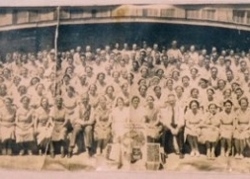
Our Italian Silicon Valley roots

by Cookie Curci
Most of the important things I've learned in life- about caring, giving, strength and reliance, I've learned from my family. They have taught me valuable life lessons. Their lessons didn't come with preaching or lectures, they taught by example. Their hardworking, honest lifestyle set the goals and desires for future generations. Each family member taking a little of what our grandparents taught us and bringing it to the next generation.
One of our valley's most productive commodities was once the prune industry.
Many of us today can trace our family roots to those early years when immigrants to the Santa Clara Valley sharecropped or owned their own fruit ranches. My grandparents were among these young; inspiring ranchers who came to this valley from another land, and made a success of their new beginnings.
In 1850 Isaac Bird came here from England, around that time Ira Cottle emigrated here from Missouri. In 1873 Wm. Cozzens and sons came to the valley and brought an improved way of evaporating fruit.
Like our valley's earlier, illustrious, residents, my grandparents, the Rizzolo's and DiNapoli's also emigrated here. In the early 1900s they made that long journey from Italy to Ellis Island and on to California. Like many of their generation, they were attracted to California's prime landscape. They had read of the European agriculturists that touted the Santa Clara Valley as a prime location for growing French plums. Based on this knowledge, the young immigrants recognized the areas potential for fruit production and with a burning desire to carve out a successful niche for themselves, they took that voyage of a lifetime that would eventually bring them to the Santa Clara Valley. My Grandma and grandpa Dinapoli planted rows of plum trees in the Almaden valley. With the help and support of their 8 healthy offspring they were assured success.
It was around this time that Henry Willard Coe developed the process of sulfuring dried fruit and revolutionized the local fruit industry.
During these years, local fruit orchards produced bountiful crops, which created employment, not only for the family's who owned the farm lands but also for the multitude of immigrants to the valley.
My grandparents purchased land in the Almaden valley and also on the El Camino Real. Grandpa share cropped for a while so he could earn enough to eventually purchase the land. But like most heads of family, who sold all they owned to come to California, grandpa had a plan, and he was prepared to risk it all on his dream.
He had read of the European agriculturists who touted this location as a prime area for growing French plums.
Based on this knowledge, grandpa recognized the area's potential for fruit production and with a burning desire to carve out a successful niche for himself, he planted rows of plum trees on his Alameda ranch.
But success didn't come without sacrifice, and family members would be called upon to carry their share of the load. They would have to put ranching ahead of everything else, including their education and social life. Summer time meant long hot days on their hands and knees under the hot blistering sun helping to bring in the crops. They would wear overalls, with knee pads made of grandma's old linens and dresses, anything to lesson the pain of kneeling for hours at a time on the hard ground. It was never easy, but it was a sacrifice that every early ranch family was willing to make for the sake of their family's survival.
Each year, the family transported their harvested prunes to the processing plant in the family's old flatbed truck. At the wheel was Papa DiNapoli, grandma by his side, and his kids holding down the wooden prune crates. The kids were especially delighted, because they knew when Papa got paid for his prune harvest, as a special treat, they would all receive an ice ream bar, from Mr. Mullins Almaden grocery store.
Local valley ranchers all made this same seasonal trek to the Sunsweet fruit facility on Lincoln Avenue, between Fruitdale Avenue and Auzerias Street.
Like all that came to our valley during the great migration, they came in search of a new and better life; and like most farmers, they struggled through the yearly stress and uncertainty of bringing in the crops.
Life may have been tough for our early settlers, but children of these early ranchers, whose heritage goes deep into the valley soil, will be the first to tell you that their family life was uniquely good too; they may not have had much in material assets, but they were rich in the things that mattered. They felt a deep love and respect for their hard working immigrant parents, and today share a sense of pride in their traditions and rich agricultural history.
The trees and blossoms are gone now, but the providence that brought our pioneer families here lives on in each new generation that chooses to make their home in the valley of the heart's delight.
You may be interested
-
“The Art of Bulgari: La Dolce Vita & Beyond,...
by Matthew Breen Fashion fans will be in for a treat this fall when the Fine Arts Museums...
-
13th Annual Galbani Italian Feast of San Gen...
In September of 2002, some of Los Angeles' most prominent Italian American citizens got to...
-
1st Annual Little Italy Cannoli Tournament
Little Italy San Jose will be hosting a single elimination Cannoli tournament to coincide...
-
Candice Guardino Brings GILDA AND MARGARETTE...
Candice Guardino is adding to her list of successful theatrical productions with the debut...
-
Festa Coloniale Italiana 2012
We are very excited to announce that on Saturday, August 11, The San Francisco Italian Ath...
-
ISSNAF medical imaging science chapter meeti...
AGENDA 12.00 – 12.15 Light lunch12.15 – 12.30Welcome addresses Lorenzo Mannelli, MD, PhD...
-
Little Italy Arch Groundbreaking Celebration
**The ceremony will be held in Little Italy SJ at W. Julian and North Almaden (Next to Pae...
-
The Great GRAVY/SAUCE Cooking Competition
September 26/27 - 3 PM - 1651 N. Highland Ave, 90028The Great Gravy/Sauce Cooking Com...










